Hummingbirds Control Their Flight with a Newfound Mechanism
When zooming forward, hummingbirds rely on a unique internal “cruise control”
Hummingbird hovering in flight.
Kenneth Lui/Getty Images
Hummingbirds are the Olympic gymnasts of the avian world. They zip around at remarkable speeds, hover in place and fly in all directions, including backward and while upside down. They can even perform flips.
To achieve such agility, hummingbirds use distinct modes of visual processing to control different types of flight, researchers report in the Proceedings of the Royal Society B. In particular, the scientists uncovered a seemingly unique mode that guides hummingbirds’ speed when they are flying forward.
The findings come from an analysis of more than 3,500 hummingbird flights inside a 12-foot-long tunnel with a perch at one end and a feeder at the other. Moving patterns projected on the tunnel walls manipulated the hummingbirds’ sense of optic flow—the perceived motion of surroundings while traveling through the world. The speed of that motion, called pattern velocity, is a key visual cue that many animals use to adjust their own speed and position as they move.
On supporting science journalism
If you’re enjoying this article, consider supporting our award-winning journalism by subscribing. By purchasing a subscription you are helping to ensure the future of impactful stories about the discoveries and ideas shaping our world today.
The researchers expected that if the hummingbirds were using pattern velocity cues to control their forward flight speed, they would see the birds speed or slow in sync with vertical stripes projected on the side walls. But instead “it seemed more the case that they have their own internal speedometer or internal gauge” for forward flight, says study co-author Vikram Baliga, a comparative physiologist at the University of British Columbia.
Any movement that defied the hummingbirds’ expectations of how their…
Read the full article here







